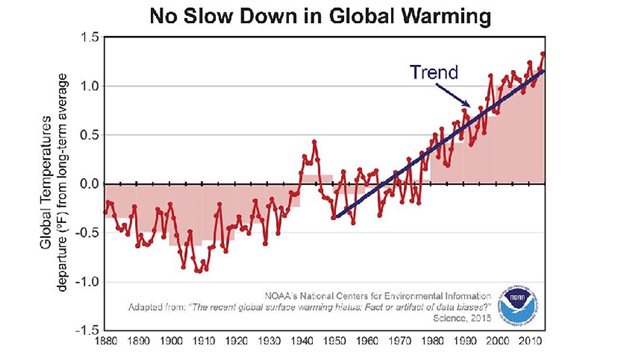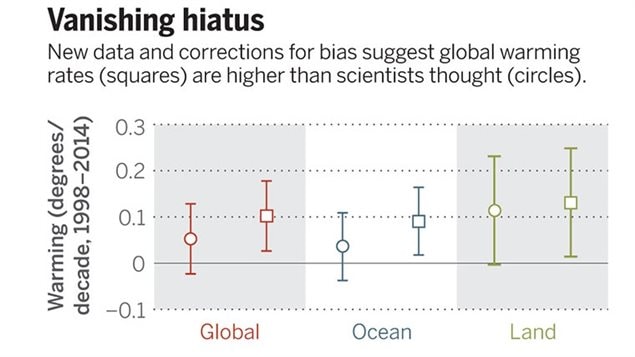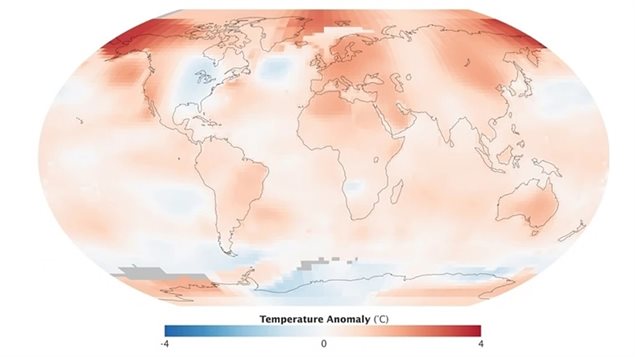A new report based on improved evidence shows that the claims of a warming pause in the past few years, is a myth.
In fact data showed that 2014 was the warmest global year in 134 years of temperature collection, with 2015 on the way to beat that.
In 2013, the International Panel on Climate Change reported global surface temperature “has shown a much smaller increasing linear trend over the past 15 years [1998-2012] than over the past 30 to 60 years,”
This led some, mostly non-scientists, to claim that this “pause” was evidence that climate models predicting steady increases in temperature were wrong and that anthropogenic global warming (AGW) is not true.

However, the surface temperature only accounts for a small percentage of the earth’s surface with 90% of heat going into the ocean. In response to one short term study of low ocean depth that concluded ocean heat content (OHC) and CO2 levels were inconsistent with climate models, other scientists performed a more in-depth analysis which showed the ocean heat content was indeed consistent with models if more data had been included in the previously mentioned study.
For their part the US-based National Oceanic and Atmospheric Administration (NOAA) used newly improved and corrected data in this latest analysis. The adjustment to previous data was only slight but that was all that was required to realize the upward trend had not “paused”.
With the last decade, many more data collection sites have been added to underreported areas, stations which may have been skewed by nearby development have been removed, and a vast network of ocean data buoys have been added.

The NOAA scientists found that the world warmed 0.086 degrees Celsius per decade between 1998 and 2012. This was more than double the previous so called “pausing” estimates. When the researchers included 2013 and 2014—when record-breaking heat spread across the globe—warming per decade jumped to 0.116 degrees Celsius.
“The fact that such small changes to the analysis make the difference between a hiatus or not merely underlines how fragile a concept it was in the first place,” said Gavin Schmidt, a climate scientist and director of the NASA Goddard Institute for Space Studies who was not involved in the research.
According to Thomas R. Karl, Director of the National Centre for Environmental Information, “Adding in the last two years of global surface temperature data and other improvements in the quality of the observed record provide evidence that contradict the notion of a hiatus in recent global warming trends.” He added, “Our new analysis suggests that ….. the rate of warming over the first 15 years of this century has, in fact, been as fast or faster than that seen over the last half of the 20th century.”

said Tom Karl, director of NOAA’s National Centers for Environmental Information and lead author of the study. He said the study showed the rate of warming during the last half of the 20th century is virtually identical to that of the 21st century,
“There certainly is variability from year to year, and one can find periods in the record where there are small changes,” but over the long term, the world is still warming at an alarming rate,” he said
The research, published in the peer-reviewed journal Science this week, is just the latest in a growing number of studies refuting the idea of a slowdown or stop in global warming.
Michael Mann, a climate scientist and director of the Earth System Science Center at Pennsylvania State University. Mann said the study doesn’t prove that warming never slowed, but rather that when it did, it was short-lived, localized and had little impact on the world’s overall warming trend over the last century.







For reasons beyond our control, and for an undetermined period of time, our comment section is now closed. However, our social networks remain open to your contributions.